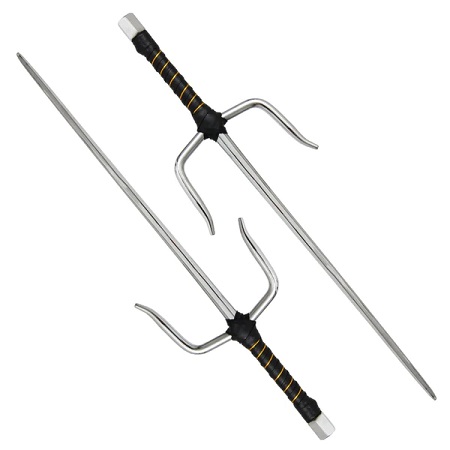The Sai: History Behind the Weapon
In this article, we delve into the history and significance of the Sai, a weapon that has captured the imaginations of martial artists and weapon enthusiasts around the world.
Origins of the Sai
The Sai, initially a farm implement utilized for digging and weeding, evolved into a martial arts weapon. While its usage spread across various Asian countries such as Japan and China, its likely origins trace back to China.
History
The exact origins of the Sai are somewhat murky, but it is believed that the weapon was developed on Okinawa sometime in the 15th or 16th century. The island was known for its martial arts traditions, which drew upon a wide range of influences from China, Japan, and other parts of Asia. Over time, these traditions evolved into a unique style of martial arts that was heavily focused on close combat and self-defense techniques.
The Sai quickly became a popular weapon among these martial artists, who appreciated its unique design and versatility. Unlike other weapons of the time, such as swords and spears, the Sai was designed to be used in close combat situations, where its prongs could be used to grip an opponent’s weapon or limb, allowing the user to disarm or disable their opponent.
As the popularity of martial arts grew throughout Japan and beyond, the Sai became a widely recognized and respected weapon. Many different styles of martial arts incorporated the Sai into their training regimens, and it was often used as a symbol of authority among law enforcement officers and other officials.
In modern times, the Sai continues to be a popular weapon among martial artists and weapon enthusiasts around the world. It is often used in demonstrations and competitions, where its unique design and versatility make it a formidable weapon in the hands of a skilled user.
Overall, the history of the Sai is a fascinating subject that offers a glimpse into the rich and complex martial arts traditions of Okinawa and beyond. Whether used for self-defense or simply as a symbol of authority and respect, the Sai remains a powerful and versatile weapon that has stood the test of time.
Design
The Sai is made up of a long, central shaft with a handle on one end and two curved prongs on the other. The shaft is typically made of iron or steel, while the handle and prongs are often made of wood or another durable material.
The prongs of the Sai are designed to be used both defensively and offensively. They can be used to parry and block attacks, as well as to strike an opponent in close combat. The handle of the Sai can also be used to strike an opponent, making the weapon highly versatile in combat situations.
Sai Components
Sai Construction
Sai construction is a fascinating subject that has interested martial artists and weapon enthusiasts for centuries. The Sai is a unique weapon that is made up of several different components, each of which plays a critical role in the weapon’s overall design and function.
The central shaft of the Sai is typically made of iron or steel, which gives the weapon its strength and durability. This shaft is often straight, although some variations of the Sai feature a slightly curved design that can make the weapon more versatile in combat situations.
At one end of the shaft is the handle, which is typically made of wood or another durable material. The handle is designed to be gripped firmly by the user, allowing them to wield the weapon with precision and control.
At the other end of the shaft are the prongs, which are the most distinctive feature of the sai. The prongs are typically made of the same material as the shaft and are curved inward towards each other. This design allows the user to grip an opponent’s weapon or limb between the prongs, giving them an advantage in close combat situations.
In addition to the main components of the Sai, there are also several other features that can be found on some variations of the weapon. For example, some Sai feature rings on the handle that can be used to deflect an opponent’s weapon or to strike an opponent in close combat. Other Sai may feature spikes or other protrusions on the prongs, which can make the weapon more effective in certain combat situations.
Overall, the construction of the Sai is a complex and fascinating subject that requires a deep understanding of the weapon’s design and function. Martial artists and weapon enthusiasts alike have spent centuries studying the Sai and perfecting their techniques with this unique weapon, and it remains a popular choice for those who are looking for a versatile and effective weapon for close combat situations.
Use in Martial Arts
The Sai is best known for its use in martial arts, particularly in Okinawan kobudo and karate. In these disciplines, the Sai is used to block attacks and to disarm opponents. It is also used to strike vulnerable areas on an opponent’s body, such as the wrist or elbow.
The use of the Sai in martial arts requires great skill and training. Practitioners must be able to move quickly and fluidly, using the weapon in a way that is both efficient and effective.
Kata utilizing Sai typically involve wielding the weapon in pairs, with one held in each hand. In contemporary Okinawan Kobudo, practitioners commonly learn five Kata, which are choreographed sequences of movements. Among these, two are fundamental Kata.
The effectiveness of the Sai as a weapon is evident in its unique shape, designed for swift jabs and strikes as well as defensive maneuvers. These defensive techniques encompass various blocks, parries, and captures against attacks from different angles and heights. Emphasis is placed on utilizing the sharp tip, main prong, and pommel, alongside rapid grip changes for executing multiple jabs and strikes.
One frequently depicted technique involves using one of the Sai’s hooks to entrap and lock an attacker’s blade. Some variations of the Sai have inward-pointing hooks toward the main prong to facilitate this maneuver. While this technique may not completely immobilize the attacker, it effectively hinders their movement in close combat situations.
In Japanese, due to the absence of morphological plural forms, the term “Sai” can refer to either a single weapon or multiple ones. “Nicho Sai” denotes a kata utilizing two Sai, while “Sancho Sai Kata” refers to Kata employing three Sai.
Pop Culture and the Sai
The Sai has also made appearances in popular culture, most notably in the Teenage Mutant Ninja Turtles franchise. The turtles are often depicted using Sai as their weapon of choice, which has helped to popularize the weapon among a new generation of fans.
Final Thoughts
The Sai is a fascinating weapon with a rich history and significant cultural significance. Its use in martial arts and pop culture has helped to keep the weapon relevant and popular even in modern times. We hope that this article has provided you with a deeper understanding and appreciation of the Sai.
Hungry for More Knowledge?
We trust you enjoyed this article. If you’re ready to dive deeper into traditional martial arts weaponry, please have a look at the articles mentioned below.
Next Martial Arts Weapons article: Kama Traditional Martial Arts Weapon
Previous Martial Arts Weapons article: The Bo Staff in Karate
Delve into this extensive article that offers a deep dive into the world of Martial Arts Weapons right here at Dojo Directory.


